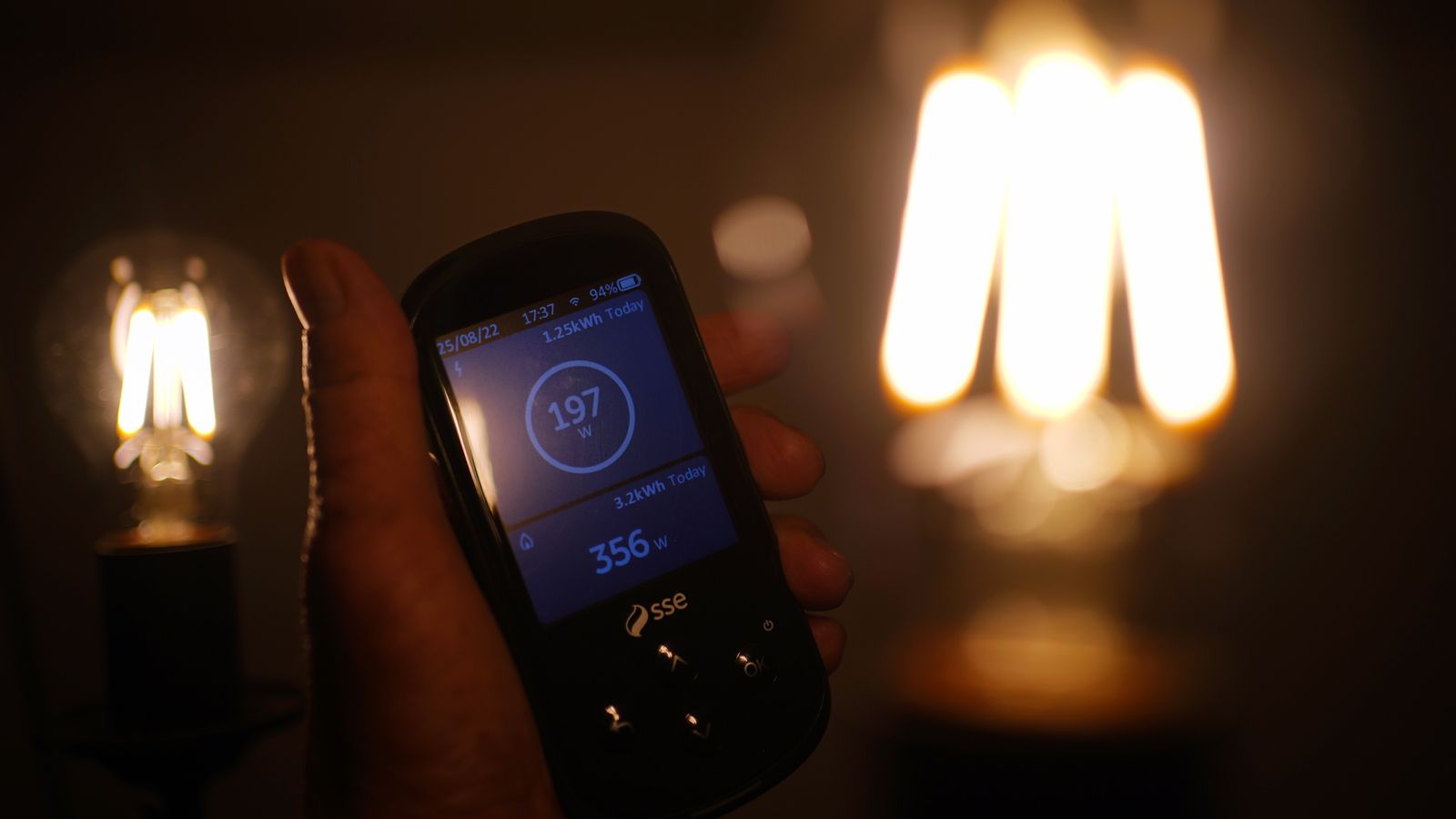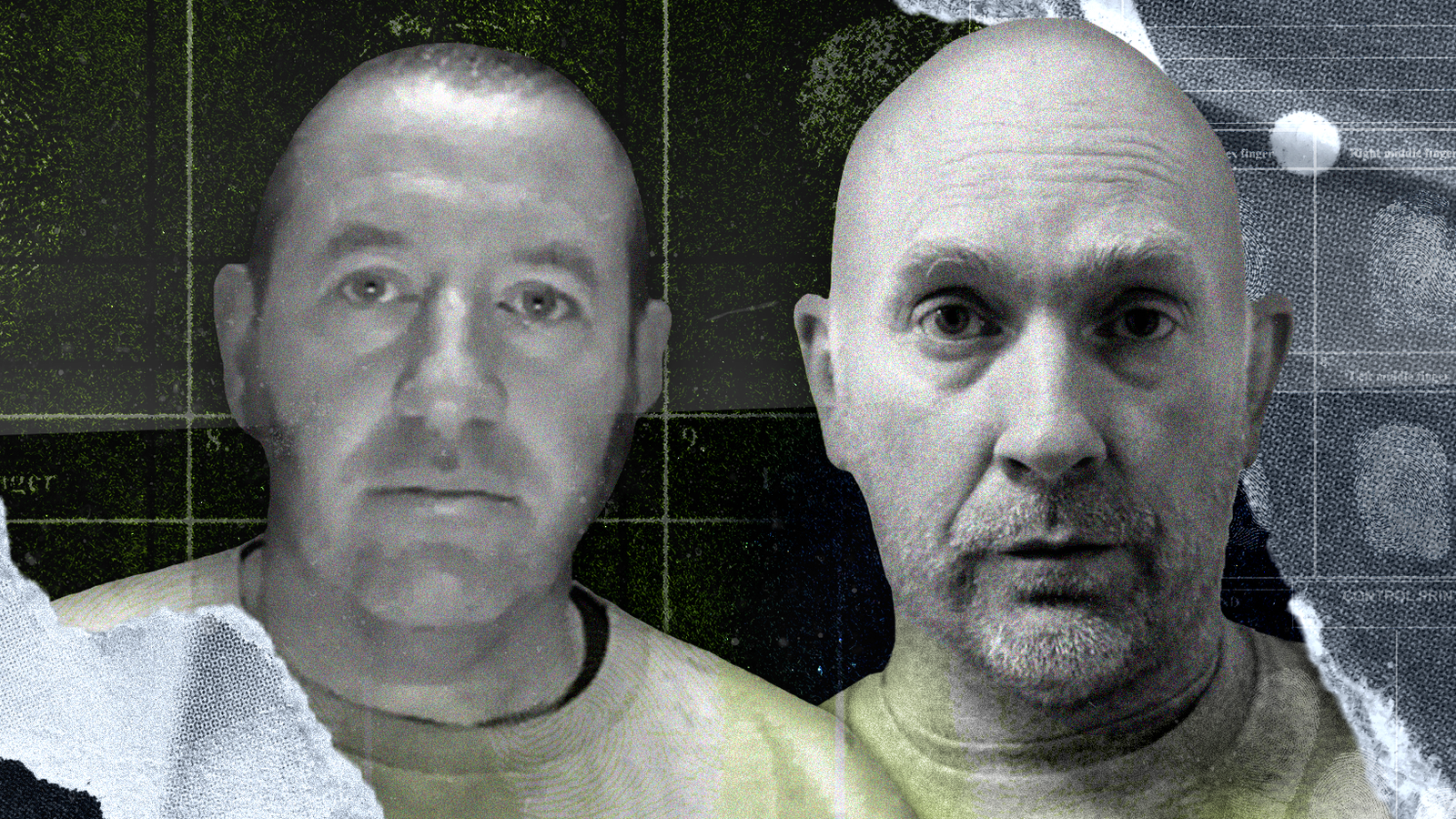A police officer used COVID lockdown regulations to falsely arrest Sarah Everard before he kidnapped, raped and strangled her and then burned her body, a court has heard.
Wayne Couzens, 48, used handcuffs and his Metropolitan Police-issue warrant card to snatch his victim as she walked home from a friend’s house in Clapham, south London, on the evening of 3 March.
Images seen at the Old Bailey showed Ms Everard talking to her killer moments before he abducted her.
Couzens sentencing day one – as it happened
The firearms officer, who had finished a 12-hour shift at the US Embassy that morning, drove to a remote rural area northwest of Dover in Kent, where he parked up and raped Ms Everard.
The 33-year-old marketing executive, who lived in Brixton, south London, was strangled with Couzens’ police belt by 2.30am the following morning.
Couzens then burned her body in a refrigerator in an area of woodland he owned near Ashford, Kent, before dumping the remains in a nearby pond.
Days later, amid extensive publicity about Ms Everard’s disappearance, Couzens took his wife and children on a day out to the woods, allowing the youngsters to play close by.
Couzens was at the Old Bailey for a two-day sentencing hearing.
In other evidence, the court heard:
• Statements read by Ms Everard’s family, in which they said she had been “fly tipped… like she meant nothing”
• Evidence including a fragment of a SIM card and a blood stain in Couzens’ car linked him to the crimes
• The prosecution argued that the crime was so serious a whole life sentence should be considered
Ms Everard’s family told the court about the “unbearable” suffering they have been through.
Her mother, Susan, said she was “repulsed” by Couzens and “outraged that he masqueraded as a policeman”, adding that Sarah had wanted to get married and have children.
Her father, Jeremy, said his daughter’s murder is on his mind “all the time”, while her sister Katie broke down in tears and said Couzens had “fly-tipped” Sarah “like she meant nothing”.
The crime involved “significant” planning and Ms Everard was alive for hours before being raped and murdered, prosecutor Tom Little QC said.
The circumstances of the murder are so exceptional that it could warrant a whole life sentence, he added. Couzens, who was sacked by the Metropolitan Police after admitting murdering Ms Everard, is due to discover his jail sentence on Thursday.
Speaking during the first day of a two-day sentencing hearing, Mr Little said Couzens took his wife and two children on a family trip to Hoads Wood on 7 March, where only days earlier he had set fire to Ms Everard’s body.
En route, he withdrew cash from the same service station he had been to shortly after raping and murdering his victim, the court heard.
Mr Little said he “took his family on a family trip to the very woods where days earlier he had left Sarah Everard’s body, then returned to burn it and then returned again to move it and hide it”.
Couzens allowed his children to play in “relatively close proximity to where Ms Everard’s body had been dumped in the pond”, he added.
He was arrested on 9 March and Ms Everard’s body was found the following a day – a week after she went missing.
Opening the hearing, Mr Little said Couzens’ crimes could be summarised in five words: “Deception, kidnap, rape, strangulation, fire.”
Ms Everard had had dinner with a friend in Clapham Junction and was on her way home to Brixton when she was “arrested” by Couzens during the third coronavirus lockdown.
Couzens, then a serving diplomatic protection officer, handcuffed her at about 9.34pm after showing her his warrant card, the court heard.
Mr Little said Couzens was familiar with coronavirus regulations and may have used lockdown rules to falsely detain Ms Everard.
She was described by a former long-term boyfriend as “extremely intelligent, savvy and streetwise” and “not a gullible person” who he could envisage getting into a car with a stranger “unless by force or manipulation”.
Couzens was said to be wearing his police belt with handcuffs and a rectangular black pouch, similar to a pepper spray holder, when he confronted Ms Everard.
He put her in the back of a Vauxhall Astra – hired using his own personal details and bank card – at around 9.37pm.
The married father-of-two set off for Kent, 80 miles away, a minute later. At around 11.30pm, Ms Everard was transferred from the hire car to Couzens’ own Seat car, which was left in a non-residential area of Dover.
Couzens then drove to a remote rural area northwest of Dover where he parked up and raped Ms Everard, the court was told.
The Seat was picked up on an ANPR camera on a road in the town at 2.31am. “It is by this point that Sarah Everard is most likely to have been murdered,” Mr Little said.
The moment Couzens confronted Ms Everard in south London was caught on security footage and witnessed by a couple travelling in a car.
Ms Everard was a mile from home when cameras from two buses, a refuse lorry and a marked police car caught footage of Couzens talking to her by the car, which was parked on the pavement with its hazard lights on and doors open.
The female passenger in the other vehicle said she saw Couzens and Ms Everard standing on the pavement. She watched as Ms Everard was handcuffed, Mr Little told the court.
“Sarah Everard was compliant, with her head down and did not appear to be arguing,” he said.
Mr Little added that the female passenger believed she was witnessing an undercover police officer arresting a woman whom she assumed “must have done something wrong”.
She remarked to her husband that she had seen “a woman being handcuffed” when “they were in fact witnessing the kidnapping of Sarah Everard”, Mr Little said.
The next day, 4 March, Couzens took Ms Everard’s mobile phone and threw it into a river in Sandwich, Kent. A broken fragment of an EE sim card from the phone was later found in his Seat, the court heard.
In addition, a blood stain was found on a rear passenger seat which matched Ms Everard’s DNA, the court heard.
Semen which matched Couzens’ DNA was also found on the back seat, the hearing was told.
Couzens, who the court heard was thousands of pounds in debt, wiped his phone just minutes before he was arrested at his home in Deal on 9 March.
Follow the Daily podcast on Apple Podcasts, Google Podcasts, Spotify, Spreaker
In a video shown at the Old Bailey, Couzens was seen sitting on his sofa, with his hands in cuffs, being quizzed by police.
An officer repeatedly asked if Couzens knew where Ms Everard was, saying her “family and friends are worried about her”.
Couzens, who offered no resistance, initially denied knowing her, claiming he only knew of her disappearance from watching the news.
He then told detectives he was “in financial s***” and that he had been “leant on” by a gang to pick up girls after he tried to “rip off” a sex worker he had booked online.
The following day, a week after Ms Everard disappeared, her body was found in a stream in Ashford, Kent, just metres from land owned by Couzens.
Fragments of her clothing were found in nearby woodland, where her body had previously been burnt.
Mr Little said that while Couzens was in the wood he must have “moved Sarah Everard’s heavily burnt body from where he had set fire to it, to the pond where she was subsequently found” using bags he bought from B&Q on 5 March.
In July, Couzens pleaded guilty to Ms Everard’s murder, kidnap and rape via video link from jail.
Couzens told a psychiatrist he strangled Ms Everard with his police belt, which tallied with the conclusions of a post-mortem examination which found she died from compression of the neck.
While in custody, he deliberately hit his head on the toilet bowl in his cell, suffering a cut, shortly before he was about to be interviewed, the court heard.
An ambulance was called and he was taken to hospital for treatment, before being placed under constant supervision after returning to the police station.
The court heard how Couzens would wear his police belt and handcuffs while off duty and had a profile on dating site Match.com in which he gave various false details about himself. He was also in contact with an escort through an escort service.
The police watchdog has received a string of referrals relating to the Couzens case, with 12 police officers being investigated.
A senior investigator on the Sarah Everard case, former DCI Simon Harding, told Sky News that police “do not view” Couzens as a fellow officer and that he “should never have been near a uniform”.
Speaking outside the Old Bailey in July, Met Police Commissioner Dame Cressida Dick said she was “very sorry” for the loss, pain and suffering of the Everard family.
She said: “All of us in the Met are sickened, angered and devastated by this man’s truly dreadful crimes. Everyone in policing feels betrayed.”
The Independent Office for Police Conduct (IOPC) said it was looking at whether the Met failed to investigate two allegations of indecent exposure relating to Couzens in February, just days before the killing.
Kent Police is also being investigated over its response to a third allegation of indecent exposure dating back to 2015.
Ahead of Wednesday’s hearing, a spokesperson from the Metropolitan Police said: “We are sickened, angered and devastated by this man’s crimes which betray everything we stand for.
“Our thoughts are with Sarah’s family and her many friends. It is not possible for us to imagine what they are going through.
“We recognise his actions raise many questions and concerns but we will not be commenting further until the hearing is complete.”




